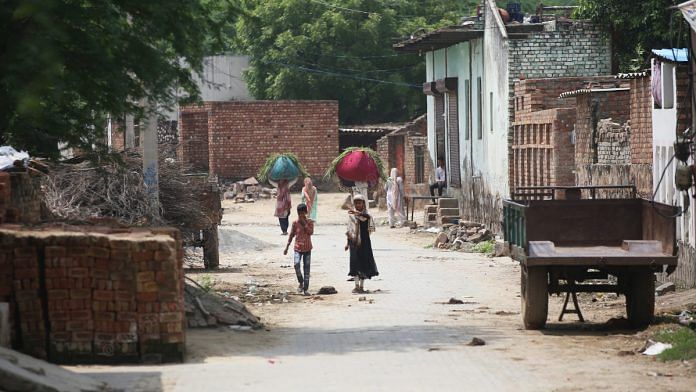Gurugram: Nuh, a backward district of Haryana that drew national attention after communal clashes broke out there earlier this week, is largely populated by the Meo Muslim community.
On 31 July, a religious procession organised by the Vishva Hindu Parishad and Matra Shakti Durga Vahini was attacked, allegedly by hundreds of youths from the Meo Muslim community, leading to clashes that left six dead, over 70 injured, and caused loss of property worth several crores. The violence spilled to adjoining districts of Haryana, including Gurugram where a mosque was set ablaze and a naib imam was killed.
The clashes put focus on the Mewat region, and its native Meo Muslims.
Mewat district — renamed Nuh in 2016 — was initially created by clubbing together the Meo Muslim-dominated areas of Gurugram district and the Hathin block of Faridabad district on 4 April 2005. In 2008, the Hathin block was added to Palwal, carved out as a new district in Faridabad.
Present-day Mewat is a cultural region comprising parts of Haryana, Rajasthan, and Uttar Pradesh. According to Saddique Ahmad ‘Meo’, a Nuh-based retired engineer and historian who has done expansive research on Meo Muslims, Mewat comprises 1,250 villages — 550 under Nuh, Palwal, Faridabad, and Gurugram districts of Haryana; 650 under Alwar and Bharatpur districts of Rajasthan, and another 50 under Kosi Kalan and Chhata subdivisions of UP’s Mathura district.
In terms of development, Niti Aayog’s 2018 rankings marked Nuh as the most backward district in the country. Ahmad said the Mewat region was once thriving, but the migration of a majority of educated people during the Partition dragged it back by a generation.
“We are a generation behind our surrounding areas. With the advancement in technology, others are marching ahead,” he said.
ThePrint looks at the history of Meo Muslims of the Mewat region.
Also read: Nuh violence got India’s attention, but Mewat wasn’t always communal
Of dynasties and kings
According to the 2011 census, then district Mewat had a 79.2 percent Muslim population while Hindus comprised 20.37 percent and the other communities made up the rest.
Ahmad said that Meos converted from Hinduism in phases centuries ago, but many Meo Muslims had Hindu names, particularly after Mahabharata characters, till the late 70s. “When India-Pakistan cricketing resumed after a long time in 1978, people here were so fascinated by the Pakistani cricketers that they started naming their children after them,” he said.
He said the history of the Meos can be traced along the Black Sea in 2000 BC.
Ahmad, who has penned 11 books on the history and evolution of Meo Muslims, said that around 750 BC, Meos are believed to have established the Median dynasty in Iran. Their sixth ruler was slain by his grandson (from his daughter’s side), Cyrus, who went on to establish the Persian empire in 550 BC, he added.
After this, Meos started moving towards Sindh (in Pakistan). In 630 AD, Arab historian-traveller Allama Balazri identified the Medh tribe (present-day Meos) along the Sindh that kept camels with two humps, said Ahmad. “From Sindh, the Meos moved to Mewar, Marwar and the Mewat regions and then some moved to Punjab too. Madri, a character in Mahabharata, was also an ancestor of the Meos. This is the reason that a number of Meos had their names after prominent characters of Mahabharata,” he added.
Ahmad went on to say that the first conversion of Meos to Islam occurred in 715 AD in Sindh at the time of attack by Muhammad Ibn Al Qasim, the second in 1053 AD by Saiyyed Salar Masud Ghazi, and the third, and one of the biggest conversions took place in 1152 AD when over 90,000 people of the community walked to the Khwaja Moinuddin Chishti Dargah for conversion.
“Until the attacks by Mahmud of Ghazni from 1001 to 1026 AD, Mewat’s boundaries started from Delhi’s Mehrauli to the north boundary of Mewar (in Rajasthan). However, after the attacks, the area shrunk till Alwar as Ghazi captured parts of Marwar and Mewar.”
In the 13th century, Ghyas ud din Balban, sultan of the Mamluk dynasty in Delhi, led three military campaigns against the Meos, he said, adding that the Mewat region had then become a buffer zone to defend the Rajputs from foreign invaders.
Source of income
According to Aftab Ahmed, Congress Member of Legislative Assembly (MLA) from Nuh, agriculture is the main source of income for more than 90 percent of the people in the district.
However, he said, for want of a canal system and also a low water table, agriculture depends completely upon rainfall. “The soil in the region is sandy and sandy loam, which isn’t very fertile. Wheat and mustard are crops most of the region grows. Only now, some people have started doing business,” he added.
Mining was also banned by the Supreme Court in 2009, he pointed out, depriving the district of another source of income.
Lack of job avenues is also driving the youth to illegal activities in the Mewat region. Of late, Mewat is being seen as developing into a cyber scamming hub, the crimes ranging from online sale scams to sextortions.
(Edited by Smriti Sinha)



